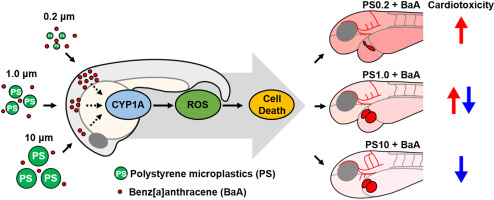A team of researchers at the Korea Research Institute of Bioscience and Biotechnology (KRIBB) revealed that the smaller the size of microplastics, the greater the accumulation of carcinogens in the body, which can lead to combined toxicity and cause heart deformities.

Microplastics (MP) are formed through the weathering of plastic waste that has entered the environment. Due to their small size of less than 5 millimeters, they are not filtered out by sewage treatment facilities and flow directly into rivers and oceans, destroying the environment, as well as threatening human health when consumed as seafood. Additionally, microplastics can adsorb various organic pollutants in the environment, posing a risk of combined toxicity.
Accordingly, the team led by Professor Jeong Jin-young of KRIBB’s Center for Environmental Disease Research used a zebrafish model to investigate the effects of MP size on the combined toxicity of the carcinogen, benz[a]anthracene (BaA), using 0.2, 1.0, and 10 μm sizes of polystyrene MPs (PSMPs). Consequently, they found that small-sized microplastics of 0.2 μm enhanced the toxic effect of BaA leading to cardiac defects and disruption of vessel formation.
Therefore, the smaller the size of microplastics, the more they accumulate in the body, and the more toxic they become, causing adverse effects on the heart.
Interestingly, however, large PSMPs canceled the combined toxic effect through decreased body burden, whereas medium PSMPs showed a tendency to create a balanced effect in toxicity.
Zebrafish are animal models used for understanding the human pathogenesis of metabolic diseases and identifying potential therapeutic options and are often used to complement other animal models like rodents.
“We found that small-sized microplastics accumulate more in the body and increase the expression of CYP1A, a gene that causes cardiotoxicity, such as inhibition of angiogenesis,” said Professor Jeong. "This study shows that microplastics and organic pollutants may accumulate in the body by adsorption and cause complex toxicity so further research is needed to unravel these complexities.”
The study was published in the online edition of the environmental science journal Chemosphere on April 19.
Related articles
- BMS Korea scores nod for rare oHCM heart disease treatment
- BioMe, Celltrion working on FMT capsule to target resistant enteric infections
- Will Entresto’s reimbursement be expanded to heart failure with ejection fraction above 40%?
- DIGMBIO, Inno Pharma Screen to develop KRAS cancer drugs with molecular glue tech

